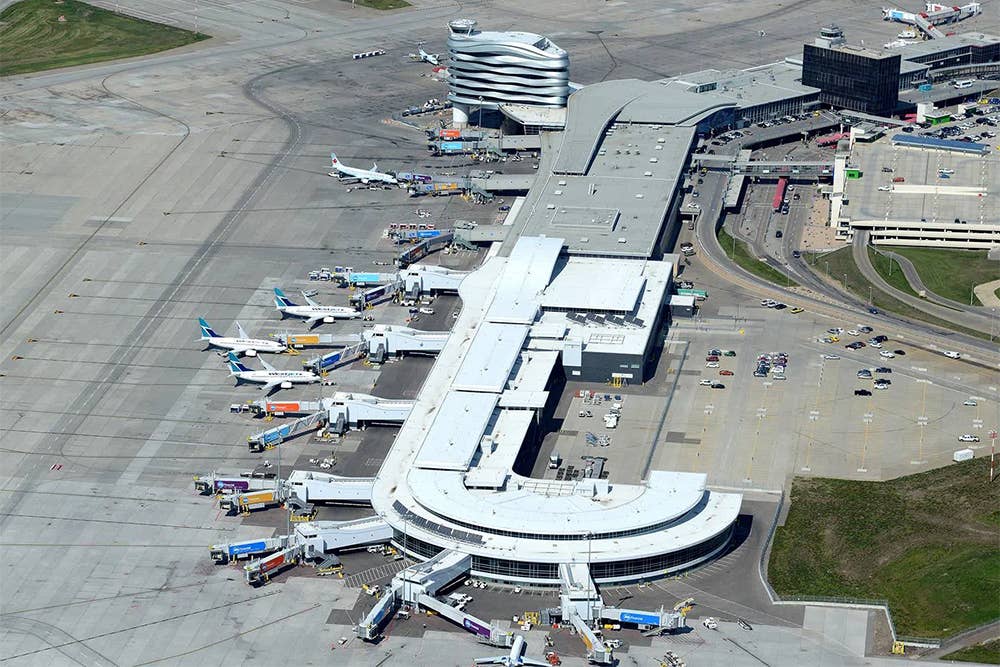Canadian Airport Betting Big on Hydrogen
Edmonton International Airport is getting ready for emergence of hydrogen aircraft.

[Courtesy: Edmonton International Airport]
Editor's Note: This article originally appeared on FreightWaves.com.
Airlines and fuel providers are experimenting with using hydrogen to power aircraft and vehicles, and Edmonton International Airport (CYEG) aims to be “on the leading edge of that,” according to vice president Myron Keehn.
“I think hydrogen for aircraft is coming quicker than we think,” said Keehn, the Canadian airport’s vice president of air service, business development, environmental, social and governance, and government relations.
“The best way to predict the future is to create it instead of having it happen to you.”
Myron Keehn, vice president of air service, business development, environmental, social and governance, and government relations, Edmonton International Airport
He predicted the Edmonton area would be using hydrogen aircraft by 2025—specifically because of the nature of the region’s route structure, and the ability to support fueling aircraft with hydrogen at the base.
“We have lots of routes that can sustain that flight to fly there and back, so you don’t need two sources of hydrogen at both ends,” Keehn said.
Alberta, including the Edmonton region, produces more than 60 percent of Canada’s hydrogen. “You have to have a supply of low-carbon and easily available hydrogen, which we have,” Keehn said.
The airport is focused on creating demand for low-carbon hydrogen, assuming that the supply will follow. Many in the industry are taking the opposite approach and waiting on supply before investing in hydrogen technology.
Creating demand for hydrogen will lead to supply, as well as create jobs and bring new investments into the region, the airport said in a release. The goal is to show that using hydrogen as a fuel is not only possible, but practical.
This isn’t the first time CYEG has led the charge. It was the first airport globally to sign Amazon’s The Climate Pledge, which includes a commitment to be carbon neutral by 2040.
The airport’s latest announcements include:
- An agreement with SBI BioEnergy Inc. to lower emissions through the development of sustainable aviation fuels, biodiesel and hydrogen.
- An agreement with SixRing to produce “one of the world’s cleanest drop-in aviation fuels” and secure clean hydrogen as a “key input.”
- A memorandum of understanding with Hydra Energy to convert CYEG’s airside light-, medium- and heavy-duty vehicle fleet to run on a hydrogen-diesel co-combustion system.
- A memorandum of understanding with Japan Overseas Infrastructure Investment Corporation for Transport & Urban Development to promote innovation in logistics, e-commerce and distribution with Edmonton’s Airport City Sustainability Campus and Canada’s first consumer-facing hydrogen hub.
“I think it’s safe to say that we’re one of, if not the, global leader in [the hydrogen] space for airports,” Keehn said.
Hydrogen Vehicles and Carbon Emissions
Edmonton airport will likely have “one of the largest fleets of hydrogen vehicles in an airport ecosystem in the world,” according to Keehn. Since hydrogen-powered vehicles don’t emit greenhouse gasses, the main environmental consideration is how the hydrogen is produced.
Many industry players refer to hydrogen colors based on how they are produced. Green hydrogen is produced by using renewable energy to power electrolyzers that split water into hydrogen and oxygen. Blue hydrogen is produced using natural gas, but the related greenhouse gas emissions are captured. Gray hydrogen is produced using natural gas without capturing the emissions.
“When it comes to hydrogen for us, we’re color agnostic. What we’re concerned with is the carbon intensity of that hydrogen,” Keehn said.
The airport is partnering with SBI BioEnergy to produce hydrogen on demand using renewable natural gas, which the airport says is 90 percent less carbon intensive than producing gray hydrogen.
“SBI is excited to work with [Edmonton International Airport (EIA)] towards meeting its ESG [environmental, social, and corporate governance] goals. Together, this collaboration will make EIA more sustainable by reducing its reliance on fossil fuels without incurring additional infrastructure costs,” Inder Pal Singh, founding president and CEO at SBI BioEnergy, said in a release.
Building ESG Into Operations
EIA is putting together a comprehensive sustainability strategy covering all aspects of ESG, including GHG emissions. It will include details about the amount of hydrogen the airport will need to support its many investments.
“What we’ve done differently than others is we don’t have an ESG department sitting separately. ESG is built into the business. It’s permeated throughout the company,” Keehn said.
The airport considers the entire process from where and how things are produced to what the impacts are on the environment and indigenous communities. Two indigenous organizations have been partners invested in the Edmonton hydrogen hub since the beginning, Keehn said.
The airport has a “living wall” with about 8,000 individual plants of 32 different species. Some of the species have been listed by NASA as good plants for cleaning air. EIA is also growing hemp to replace plastic in straws and potentially things like door panels in the future.
Edmonton airport is in the process of building the “world’s largest solar farm at an airport.” Keehn said it will generate more than 20 times the energy the airport will need initially, leaving the rest to help power local homes until the airport needs it.
“The world is going that way, so we can either lead, follow, or get out of the way. And we want to lead,” Keehn said. “The best way to predict the future is to create it instead of having it happen to you.”

Sign-up for newsletters & special offers!
Get the latest FLYING stories & special offers delivered directly to your inbox






